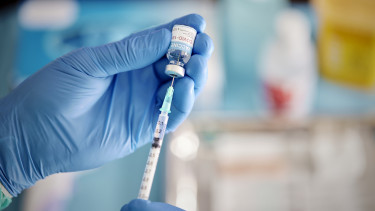COVID-19: Death toll over 37,000 in Hungary


The fact that all percent positive readings are a lot higher than a year ago and that all edged higher from a day earlier do not bode well for the future, but there are definitely promising signs. As you can see on the charts below, the 3-day / 21-day test positivity rate is back under 100%, but due to the weekend impact we need to see the reports in the second half of the week to be able to draw more reliable conclusions. However, it rose to 87.61% on Monday from 78.23% on Sunday.
IF WE WANT TO BE CERTAIN THAT THE KEY EPIDEMIOLOGICAL FIGURES ARE STARTING TO IMPROVE, THE 7-DAY AVERAGE OF THE 3-D/21-D POSITIVITY RATE WOULD NEED TO GO SOUTH OF THE 100% MARK and stay there.
On 8 December, for the first time in months, it fortunately dropped to under 100% and is currently at 91.12%. It has been falling since 1 December (106.3%), while it was as high as 160% in late October.
The abatement of the current 'wave' is first be indicated by the percent positive peaking and retreating. It is followed by a drop in daily new COVID-19 cases, hospitalisations, the number of ventilated patients, and eventually coronavirus-related deaths.
Changes in the positivity rate are reflected in the other epidemiological data with a delay:
- new cases– 3 to 5 days
- hospitalisations – 7 to 10 days
- patients on ventilator – 12 to 15 days
- deaths – 18 to 22 days.



Omicron is here
The Omicron variant of coronavirus has appeared in Hungary too, announced Chief Medical Officer Cecília Müller on public television M1 late on Monday. It was detected in two samples, she said. Note that it was a private lab that reported the presence of Omicron, not public authorities.
News portal Telex reported that a new PCR test introduced this year by the Neumann Labs diagnostic laboratory has recently demonstrated the presence of the Omicron coronavirus variant, according to a statement from the laboratory.
“The mutation infected a couple who had not visited abroad, so they must have contracted the disease at home. In addition to the confirmed Omicron infection of the couple, the Hungarian laboratory is also investigating other suspicious cases,” they wrote.
Before the Hungarian announcement, The Times of Israel reported that among the 55 Omicron variant cases detected in Israel, one of the infected persons arrived from Hungary.
Death toll over 37,000
Over the past 24 hours, SARS-CoV-2 claimed 195 lives in Hungary, according to data by the Coronavirus Task Force. The death toll exceeds 37,000, which secures Hungary a leading position in the region and makes it one of the worst performers in the world. The death toll since 1 August is already 8% higher than in the same period a year ago. (Israel was added for it is often a benchmark in comparisons with Hungary due to a similar, albeit slightly higher, vaccination rate, and also to demonstrate what a huge difference the management of the pandemic in respect of lockdown measures can make in terms of fatalities. There are, of course, various other factors at play, such as the general health of the population.)
If you don't think the graph below does Hungary justice in terms of Covid deaths, feel free to check out other Covid mortality stats. As for the argument that only excess mortality can show an accurate picture in this respect due to the different methodologies Covid deaths are calculated, note that the Central Statistical Office (KSH) will publish those data but with months of delay, and we are unlikely to have the final tally before next year's parliamentary election.
The tables below show how the changes in the number of daily new confirmed COVID-19 cases, hospitalisations and the number of ventilated Covid patients in 2021 and 2020. These are all 7-day averages to avoid distortions caused by comparing weekdays with weekend days when authorities do not publish statistics, and the aggregate data released on Mondays have to be distributed for three days with a certain methodology.
In the top chart we compared the figures of 13 December to one, two, three, and four weeks earlier. The second chart shows the week-on-week changes.
The number of new cases does show an improvement, and the 7-day average is already 31% lower than a week ago and 43% lower than a fortnight ago. The number of Covid patients in hospital also went down 9.0% w/w, which compares with a cc 1% rise a year ago. The number of ventilated patients, however, is practically flat vs. -4.1% in the base period and +20% compared to two weeks ago. These figures give reason for cautious optimism that the current 'wave' could have peaked.
Note that the ventilation data are adjusted by Portfolio's methodology, i.e. the official daily figures have been adjusted 40% higher since 28 Nov, not just for the sake of comparability but also to reflect reality more accurately. It is because the Coronavirus Task Force unexpectedly started to request hospitals to submit both invasive and noninvasive ventilation statistics, but it publishes only the number of Covid patients who are intubated (invasive ventilation) which resulted in a cc. 40% drop in the official number of ventilated Covid patients.


The situation in hospitals
The following charts show changes in two of the key metrics in the pandemic, the number of Covid patients in hospital and on ventilator as well as their relevant ratios.

On the charts below the 0% line is important. When the curves are under 0% there’s a decline, when they go over 0% it’s an increase. The changes show that the situation in terms of hospitalisations started to worsen after 20 August.
More importantly, when a value is north of 0% but the curve descends, it means an increase at a slowing rate, rather than a decrease. If the curve is above 0% and ascending, it is an increase at an accelerating rate. When we are under 0% and the curve goes lower, it translates into an accelerating decrease, and when it goes up it marks a decelerating decrease. These charts also give reason for optimism. All three curves are under the 0% mark and descending.

The ratio of Covid patients on ventilator to those hospitalised has been rising, as the latter number has been dropping at a greater rate than the former.



Vaccination spree no more
The 'vaccination weeks' where Hungarians were able to ask for 1st, 2nd or 3rd doses of various COVID-19 vaccines without prior registration or appointment booking came to an end on 12 December. The campaign was announced for a week and then got extended by another two weeks as a response to a sharp growth in demand for vaccines. The zeal petered out fairly quickly, though.






Cover photo: Getty Images











